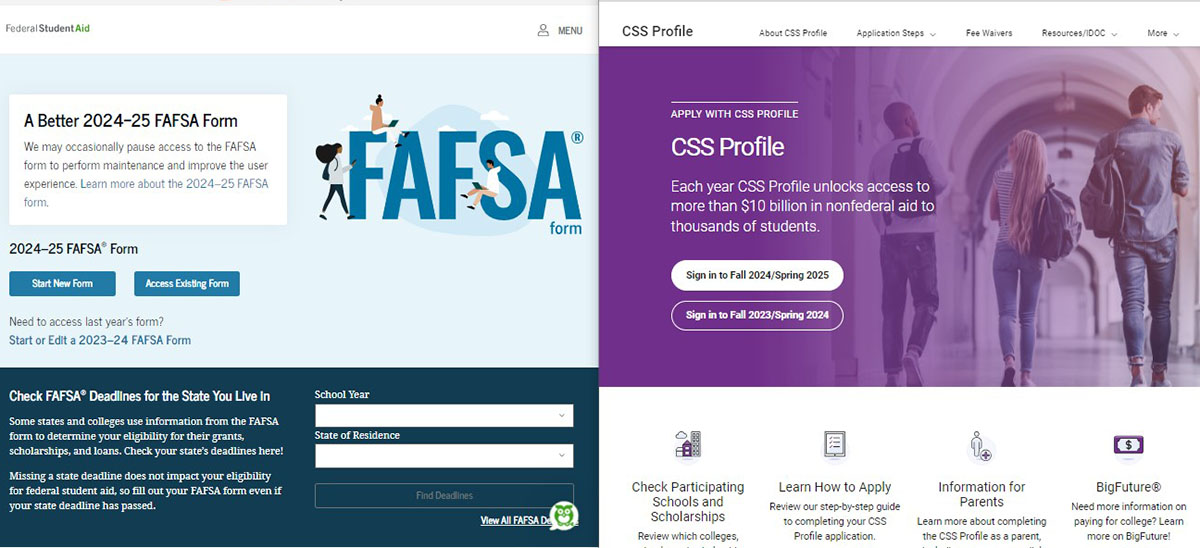As RBHS students applied to higher educational institutions starting their senior year of high school, many started considering financial aid to help pay off their education expenses. The two commonly used forms of financial aid are the Free Application for Federal Student Aid (FAFSA) and the College Scholarship Service (CSS) Profile. As the FAFSA became available in December and the CSS Profile in October, the application process for financial aid commenced.
What is the FAFSA?
Every year, the U.S. government allocates money towards helping students pursue a higher education, according to Federal Student Aid. The government provides money in many ways, commonly in three forms: federal grants, work-study and loans, which are determined by the financial situation of each applicant.
Federal grants are considered free money in which students will receive and use towards education expenses such as tuition, housing, supplies, books and transportation, according to Federal Student Aid. There are several types of grants, typically awarded to students “who display exceptional financial need,” according to the United States Department of Education. In the year 2022-2023, the maximum Federal Pell Grant awarded to a student was $6,895 for a year.
Further, work-study provides students with jobs specifically given out by the government, where the money will go towards the student’s education expenses. According to California State University, “the program encourages community service work and work related to your course of study,” which allows students to pay off their tuition while getting to work in their desired fields. The only downside to the work study, according to an article by Forbes, is “limited hours, relatively low pay and a lack of available positions at some schools.” The benefit of grants and work-study in comparison to loans is that the student receives the money as an award, without having to repay the amount in the future, according to an article by Business Insider.
Lastly, federal loans come in two forms: subsidized and unsubsidized loans. According to Nerd Wallet, only undergraduate students who are able to demonstrate financial need are eligible to apply for a subsidized loan, which accrues interest only after the individual has completed their education. On the other hand, unsubsidized loans are available to undergraduate, graduate and professional degree students without the need of demonstrating financial need. Interest accrues immediately, however, as soon as the student begins their school year.
What is the CSS Profile?
The CSS Profile is administered by College Board, a non-profit organization that focuses on providing programs such as the Scholastic Assessment Test (SAT) and Advancement Placement curriculums. CSS Profile provides non-federal aid, which allows for colleges and scholarship programs to directly award a student based on financial need and merit, according to the College Board.
Financial need is assessed similarly to the FAFSA through the submission of financial statements, such as completed tax returns and W-2 forms, according to Big Future. In addition to the statements, the CSS Profile allows families to have the opportunity “to describe unique or extenuating circumstances that affect their ability to pay” outside of financial forms, according to the U.S. News and World Report. The College Board creates additional questions regarding “annuities, home equity, retirement funds and sibling assets,” according to an article by Money, to determine the full extent of the financial situation.
Since the CSS Profile is used by the universities to determine their own financial package they offer to students, they also have the power to “set its own requirements for who qualifies for financial aid and how much the student will be offered,” according to an article by Forbes. Even if one school considers a specific factor towards financial aid, another school may not, depending on the requirement threshold. Therefore, some schools may create specific questions to be asked on the CSS Profile to have a better understanding of where a student might lie on their financial aid measure.
Besides financial aid, merit-based aid is also considered in the CSS Profile in the form of scholarships. According to College Aid Pro, “these scholarships are often awarded based on academic achievements, extracurricular activities and other non-financial factors.” Due to this, CSS Profiles may specifically ask for more questions regarding a student’s personal life.
What are the main similarities and differences between the FAFSA and CSS Profile?
The FAFSA and CSS Profile are similar, as their main purpose is to provide financial aid to students who want to attend higher educational institutions. They both require the submission of financial statements, which need to be completed every year that the student attends college, according to College Aid Pro. Their systems, however, are different in many ways.
To apply to the FAFSA, a student must be a “U.S. citizen or eligible noncitizen” according to Federal Student Aid, while the CSS Profile is available to both “domestic and international citizens,” according to The College Board. Since international students do not qualify for the FAFSA, the CSS profile allows foreigners to access financial aid at universities in the U.S., and for domestic students, it allows access to both federal and non-federal aid.
Besides the eligibility requirements, even though the FAFSA is free for all students, the CSS profile requires payment, unless waived. According to Big Future, the CSS Profile application requires $25 for the initial applied college, then $16 for every college afterward. The waiver only applies to individuals with a family gross income of up to $100,000, those qualified for an SAT waiver, or individuals in a ward or orphan of a court under the age of 24. As a substitute, the CSS profile allows students to list as many schools as they desire, whereas the FAFSA has a limit of ten schools, according to Harvard College.
Deadlines are also different for both applications. Normally, both applications open beginning Oct. 1. However, the final deadline for FAFSA is Jun. 30, according to Saving For College, while CSS Profile deadlines depend on each school with the final deadline on Feb. 15.
Have you submitted your CSS Profile or FAFSA application yet? Let us know in the comments below.















































































